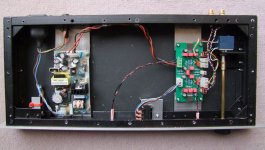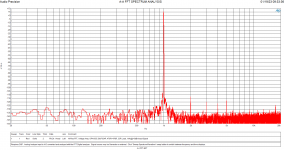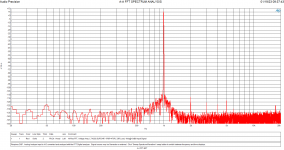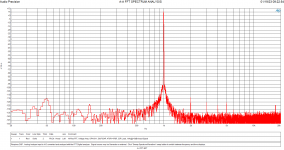This is my amp that I completed in January. I made the case a long time ago to house an earlier headphone amp. It is constructed so that nothing is fixed to the bottom panel so that, with the bottom panel removed, the underside of the PCBs can be easily accessed.
Attachments
An add-on relay board has been designed. It can be added to the headphone amp to mute a line feed so that, for example, the insertion of the headphones will disconnect that line feed to speaker power amps if they are routed through the headphone box.
There are two stereo relays controlled by the same circuitry.
There are two stereo relays controlled by the same circuitry.
Thanks.
There are more boards coming if anyone is interested.
Hello!
I would indeed be interested. I am located in Italy. Should I PM you?
73
Hi Wyn,
I really liked the sound of your amplifier, but I would really like to have a balanced output. Could you give any recommendations on how best to refine this scheme for this?
I really liked the sound of your amplifier, but I would really like to have a balanced output. Could you give any recommendations on how best to refine this scheme for this?
For a headphone stage? Why? Headphones are intrinsically a two terminal device with no ground reference, so what's the point. It just doubles the output impedance of the amp and can double the distortion. There's no benefit that I can perceive.Hi Wyn,
I really liked the sound of your amplifier, but I would really like to have a balanced output. Could you give any recommendations on how best to refine this scheme for this?
Yes, for headphones. All my headphones have balanced input. The trends in the world of hi-fi sound today are such that they switch to a balanced output even in mobile devices.For a headphone stage? Why? Headphones are intrinsically a two terminal device with no ground reference, so what's the point. It just doubles the output impedance of the amp and can double the distortion. There's no benefit that I can perceive.
As I wrote. Headphones don't have balanced or single ended input they just have a two terminal input. There is no ground reference.
If you need a balanced style (XLR) connector then wire one appropriately.
I have several quite expensive (>$1k) headphones and a number of cheap ones of various kinds, and they all work perfectly with the amp. I have no headphones that require a "balanced" output.
If you need a balanced style (XLR) connector then wire one appropriately.
I have several quite expensive (>$1k) headphones and a number of cheap ones of various kinds, and they all work perfectly with the amp. I have no headphones that require a "balanced" output.
By balanced they mean four pin out from the amp so that the minus is separate for each channel. It's not something that headphones require, but they can be wired that way by changing the (replaceable) cable to one with four separate conductors. People do it for differential amps, but call it balanced for some reason.
It's popular because with modern integrated chips it's easy and cheap to just use two chips, one for each channel and give the device a small four pin jack.
It's popular because with modern integrated chips it's easy and cheap to just use two chips, one for each channel and give the device a small four pin jack.
Hence my point. Wire the headphone output receptacle so that the -ve terminals are shorted (preferably in a star connection) to the headphone amplifier supply ground and the +ve terminals are connected to the outputs of the headphone amp and you're done. No push-pull/bridged/balanced configuration required unless you need much more power than the headphone amp can handle, in which case build two with an input phase splitter and drive each phase from a separate amp channel.By balanced they mean four pin out from the amp so that the minus is separate for each channel. It's not something that headphones require, but they can be wired that way by changing the (replaceable) cable to one with four separate conductors. People do it for differential amps, but call it balanced for some reason.
It's popular because with modern integrated chips it's easy and cheap to just use two chips, one for each channel and give the device a small four pin jack.
But you also need to invert the phase for a full-fledged balanced output. It turns out two mono amplifiers with a balanced output. Ideally, I would like to have mono amplifiers for each channel with a balanced input and a balanced output. I don't understand how to do it correctly without changing the amplifier circuit.Hence my point. Wire the headphone output receptacle so that the -ve terminals are shorted (preferably in a star connection) to the headphone amplifier supply ground and the +ve terminals are connected to the outputs of the headphone amp and you're done. No push-pull/bridged/balanced configuration required unless you need much more power than the headphone amp can handle, in which case build two with an input phase splitter and drive each phase from a separate amp channel.
Last edited:
Inspired by your design I made a bread board design with a BUF634P and I'm really impressed at how good the OPA1656/OPA1655 can perform, heck in my design the FFT even looks a little bit better than the FFT with the LT1028 or the OPA1611!
Attachments
Nice work. I’m sure it sounds great. This concept is great fun.
Jhofland made the Muscle Amp lite using 4 OPA1656’s in parallel driven by an OPA1656. Since they can drive 100mA each, it was good for up to 400mA drive. It definitely had some “Muscle”.

I made one using 8x OPA1622 in parallel. It could drive 8ohm speakers. But kind of pricey for all those OPA1622’s.


Jhofland made the Muscle Amp lite using 4 OPA1656’s in parallel driven by an OPA1656. Since they can drive 100mA each, it was good for up to 400mA drive. It definitely had some “Muscle”.
I made one using 8x OPA1622 in parallel. It could drive 8ohm speakers. But kind of pricey for all those OPA1622’s.
I'am very interested to buy HF amp (OPS1656-LMH63421) - and relay board.An add-on relay board has been designed. It can be added to the headphone amp to mute a line feed so that, for example, the insertion of the headphones will disconnect that line feed to speaker power amps if they are routed through the headphone box.
There are two stereo relays controlled by the same circuitry.
If you still have some spare, how can I order them because I'am still under moderation, so I can't start a private onversation.
Thanks in advance.
- Home
- Amplifiers
- Headphone Systems
- Low cost, high performance headphone amp using OPA1656 and LMH6321



